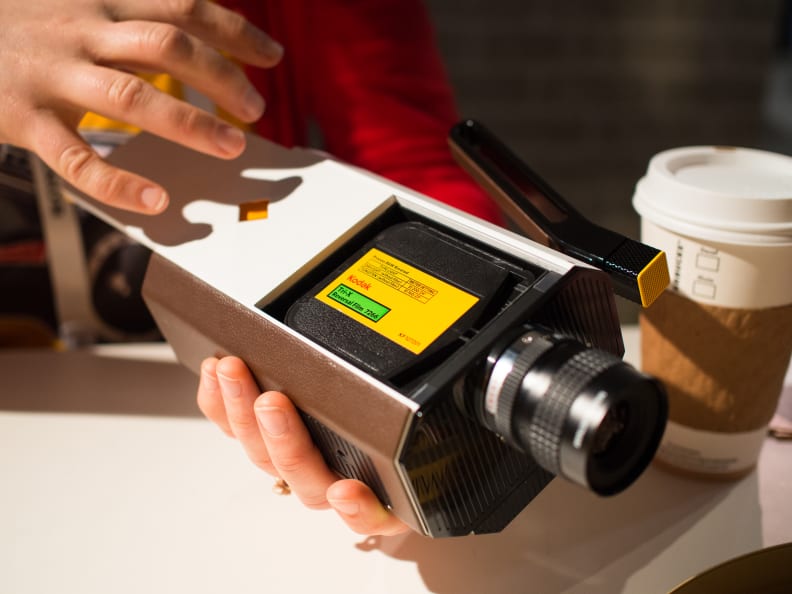While CES might be thought of as the place for bleeding-edge technology to debut, the original, Rochester, NY-based Kodak used it as a platform to introduce a new Super 8 motion picture camera. Aimed at filmmaking students, this concept camera shows a lot of promise and clearly broadcasts Kodak's intent. It comes alongside the announcement of a film development and digitization program that Kodak wants to sell to camera owners and institutions alike.
Design
Promising, but more style than substance
{{amazon name="Kodak TXR-464 Tri-X Reversal Black & White, Silent Super 8 Movie Film, 50 Foot Cartridge, ISO 200", asin="B0000BZLYQ", align="right"}}Even though we weren't allowed to handle the new Kodak camera, the Yves Béhar-designed device just begs to be held. It's a little bit retro, and a little bit modern. With a flip-out digital viewfinder, internal digital audio recording, and even HDMI-out, it's got plenty of new-school tricks up its sleeve.
This camera is a manual focus motion picture device, with no digital aids that we're aware of yet. Kodak's being cagey about how it's accomplishing a digital viewfinder while shooting film (at least without reducing the exposure of the film by a small margin) so we'll reserve judgement until the company finalizes the camera's specs for its launch later on this year.
{{ photo_gallery "design" }}
Kodak is planning some accessories for this camera, including a detachable pistol-grip handle. The camera likely won't come with a lens standard, as it's based on the common C-mount bayonette lens system created by Bell & Howell for 16mm motion picture cameras. These days, you'll find C-mount used in industrial settings for microscopes and security cameras. The camera concepts we saw on display had lenses made by Ricoh attached to them. Used lenses can be had for as little as $50 depending on the focal length and quality.
Film and Processing
Film's available, but there's a catch...
If there's one deflating aspect of this announcement from Kodak, it's gotta be that there's no planned resurrection of any color positive film. This means that everything you shoot will need to be processed. About a decade ago, when I shot Super 8 as a film student and hobbyist, Kodachrome film and processing was still available. That meant you could get your film back from the lab, thread up a Super 8 projector, and blast your uncut masterpiece onto a screen or blank wall at will.

Kodak is offering up its own cinema film stocks as Super 8 film, along with developing and digitization.
As it stands, the only film Kodak still makes is negative film, which means you won't be able to edit and exhibit yourself without getting a positive print made (good luck with that). As part of its planned film development service, Kodak plans to offer digitization, so you'll get back your negatives and a positive version in a malleable digital format.
While this is certainly convenient for those of us who are more comfortable with non-linear editing on a computer, it's a huge letdown if you were hoping to bust out the splicer and tape, as you can't screen the master version of negative stock.
On the positive side, the Super 8 cartridges that Kodak is offering are all cut-down versions of their 35mm color negative films, which are the exact same emulsions as the professionals use in Hollywood. These Vision3 packs should give you the look and feel of an epic motion picture, albeit with more grain and more depth of field. If your preference is black and white, Kodak still sells its Tri-X black and white film in cartridges, as well.
Conclusion
Cautiously optimistic
When we talked to Kodak's reps at CES, we were impressed with how enthusiastic they were about the potential for a new age of Super 8. What was even more surprising was how many people we spotted in their booth clamoring to get a peek at this new camera concept. Having shot with a stalwart Canon Auto Zoom 518 (and the all-too necessary Sun Gun) in my college days, there's undoubtedly some very exciting potential at work.
Take it from me, Super 8 is a great way to learn the ropes without having to take the plunge into more expensive 16 or 32mm motion picture cameras. Processing is more expensive, the cameras are harder to use, and that's before you start buying film stock...it can really add up.
That said, the questions remaining are really big, including some tricky ones—how will the digital viewfinder work? Will you be able to use an external recorder to grab an HDMI signal for digital dailies? How much will the camera cost? What about the film development service?
All these unknowns make us a little nervous, and we're not sure Kodak will be able to actually pull the entire thing off. But if this scrappy, once-mighty film company is about to have its triumphant third act, it's going to have to take some risks. Either way, we're on the edge of our seats.
Related Video
{{brightcove '4117763859001'}}
Meet the tester
Brendan is originally from California. Prior to writing for Reviewed.com, he graduated from UC Santa Cruz and did IT support and wrote for a technology blog in the mythical Silicon Valley. Brendan enjoys history, Marx Brothers films, Vietnamese food, cars, and laughing loudly.
Checking our work.
Our team is here for one purpose: to help you buy the best stuff and love what you own. Our writers, editors, and lab technicians obsess over the products we cover to make sure you're confident and satisfied. Have a different opinion about something we recommend? Email us and we'll compare notes.
Shoot us an email






